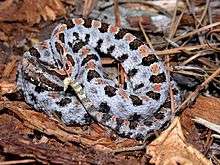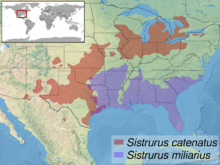Sistrurus
Sistrurus is a genus of venomous pit vipers in the subfamily Crotalinae of the family Viperidae. The genus is endemic to Canada, the United States, and Mexico.[1] The generic name is a Latinized form of the Greek word for "tail rattler" (Σείστρουρος, Seistrouros) and shares its root with the ancient Egyptian musical instrument, the sistrum, a type of rattle. Three species are currently recognized.[3]
| Sistrurus | |
|---|---|
 | |
| Pygmy rattlesnake, S. miliarius. | |
| Scientific classification | |
| Kingdom: | Animalia |
| Phylum: | Chordata |
| Class: | Reptilia |
| Order: | Squamata |
| Suborder: | Serpentes |
| Family: | Viperidae |
| Genus: | Sistrurus Garman, 1884 |
 | |
| Synonyms[1] | |
- Common names: ground rattlesnakes, pygmy rattlesnakes, massasaugas.[2]
Description
Sistrurus species differ from the larger rattlesnakes of the genus Crotalus in a number of ways. They are smaller in size, but also their scalation is different: Sistrurus species have nine large head plates (same as Agkistrodon), whereas in Crotalus (and almost all other viperids), the head is mostly covered with a large number of smaller scales. Sistrurus species have a relatively small rattle that produces more of a high-pitched, buzzing sound than does a larger rattle, like that of Crotalus.
Geographic range
Species of Sistrurus are found in Canada, the western, southern, and mid-west United States, and isolated populations in southern and eastern Mexico.[1]
Venom
Although bites from Sistrurus species are regarded as less dangerous to humans than those from Crotalus rattlesnakes, primarily due to their lower venom yield, every venomous snake bite should be considered serious, and prompt medical treatment should always be sought.
Species
| Image[3] | Species[3] | Taxon author[3] | Subsp.[3] | Common name | Geographic range[1] |
|---|---|---|---|---|---|
 |
S. catenatus | (Rafinesque, 1818) | 3 | massasauga | North America from southeastern Ontario (Canada) and western New York southwest to southeastern Arizona (USA) and northern Tamaulipas (Mexico). In Mexico, isolated population exist in southern Nuevo León and north-central Coahuila. It occurs in various habitats ranging from swamps and marshes to grasslands, usually below 1,500 m (4,900 ft) altitude. |
 |
S. miliarius T | (Linnaeus, 1766) | 3 | pygmy rattlesnake | The Southeastern United States from eastern and southern North Carolina southward through peninsular Florida and westward to Oklahoma and East Texas. It occurs in flatwoods, sandhills, mixed forests, floodplains, and around marshes and lakes. |
T) Type species.[1]
References
- McDiarmid RW, Campbell JA, Touré T (1999). Snake Species of the World: A Taxonomic and Geographic Reference, Volume 1. Washington, District of Columbia: Herpetologists' League. 511 pp. ISBN 1-893777-00-6 (series). ISBN 1-893777-01-4 (volume).
- Wright AH, Wright AA (1957). Handbook of Snakes of the United States and Canada. Ithaca and London: Comstock Publishing Associates, a Division of Cornell University Press. (7th printing, 1985). 1,105 pp. (in two volumes). ISBN 0-8014-0463-0. (Sistrurus, pp. 1040-1061).
- "Sistrurus ". Integrated Taxonomic Information System. Retrieved 4 November 2006.
Further reading
- Hubbs, Brian; O'Connor, Brendan (2012). A Guide to the Rattlesnakes and other Venomous Serpents of the United States. Tempe, Arizona: Tricolor Books. 129 pp. ISBN 978-0-9754641-3-7. (Sistrurus, pp. 72-85).
- Powell R, Conant R, Collins JT (2016). Peterson Field Guide to Reptiles and Amphibians of Eastern and Central North America, Fourth Edition. Boston and New York: Houghton Mifflin Harcourt. xiv + 494 pp., 47 plates, 207 figures. ISBN 978-0-544-12997-9. (Sistrurus, pp. 443-445).
External links
| Wikimedia Commons has media related to Sistrurus. |
- Sistrurus at the Reptarium.cz Reptile Database. Accessed 5 December 2007.